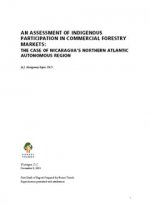An Assessment of Indigenous Participation in Commercial Forestry Markets
The Case of Nicaragua's Northern Atlantic Autonomous Region
By J. Montgomery Roper, Ph.D - Forest Trends View PublicationNicaragua’s Northern Atlantic Autonomous Region (RAAN) contains a wealth of tropical forests and has a long history of forest exploitation. Nicaragua contains the largest tropical forest north of Amazonia with nearly 23,000 km2 of broadleaf and nearly 6,000 km2 of pine forest. Over three quarters of these forests are located in the Northern Atlantic Autonomous region, which constitutes about one-quarter of the country in total area. For over 200 years, the forests of the region were the focus of an extractive economy in which foreign companies extracted timber under a concession system to remove valuable forest products, including broadleaf species such as mahogany and cedar, Caribbean pine, pine resin, and rubber. Many of the indigenous peoples of the region, who today make up a little over 60% of the population, participated in this economy by providing wage labor. Beyond providing employment, however, the extractive nature of the industry did little to develop the region. The more accessible forests were largely exhausted by the 1960s, and the industry collapsed almost completely following the successful Sandinista revolution in 1979.

